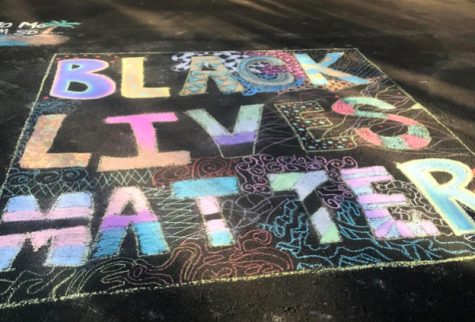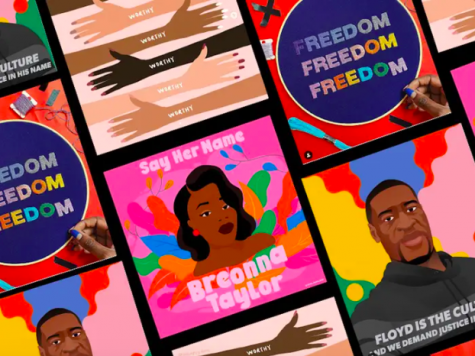Black Lives Matter Movement
June 2, 2021
Background
The Black Lives Matter (BLM) movement is a Black liberation movement that strives to eliminate white supremacy, abolish the police and create a new system of local intervening power, and to uplift Black voices. The movement began as a hashtag (#BlackLivesMatter) on FaceBook in 2013, after the acquittal of George Zimmerman, a neighborhood watch captain who fatally shot Trayvon Martin, a 17-year-old African American, in 2012. Black Lives Matter has expanded to many countries across the world. After the murder of George Floyd was broadcast to the world in 2020, protests occurred internationally, with some in La Jolla. Using social media, Black Lives Matter helped to further expose the police brutality in America.
*La Jolla is a predominantly white middle to upper class neighborhood. It is unfortunate that we do not have Black collaborators on the Hi-Tide staff. Using the knowledge of Black educators and activists, we are working towards being allies*
Content warning: police brutality, violence, and racism
The Impact of Protests
By Savannah Dennis
Black communities in America have been historically oppressed, exploited, and brutalized by the state and state sponsored violence. This is not a matter of debate but rather the reality of our inhumane societal structure. The use of protest is not a new tactic for liberation, but has instead been a form of surviving and rejecting the enslavement of black communities since the beginning of Black communities’ exploitation.

Photo via Savannah Dennis
Protests are expressed in various ways, not only through marches- performance art, sit-ins, boycotts, petitions, and music are only some of the ways that the Black liberation movements have utilized. Protests in support of the Black Lives Matter movement are crucial to Black and Brown liberation. Not only do these protests highlight the voices of the community, it also enacts substantial change.
After the murders of George Floyd and Breonna Taylor, mass protests for the Black Lives Matter movement broke out across the US and in many other countries as well. Outrage against systemic racism and the continuation of injustice brought communities together in support of Black Lives Matter.
As with many protests advocating for the liberation and protection of Black lives, demonstrations in 2020 were also met with violence from the police who beat, maced, and plowed through protesters. Taking to the streets, protesters made their movement known. However, critics condemn the vandalizing, which further highlights the racism in America. Criticizing the destruction of property only shows that people are not understanding the experiences of Black people in the US and are rather valuing things over the lives of countless human beings. As journalist Raven Rakia explains, “For 300 years, the very idea of a black person’s freedom was a direct threat to white men’s property. After slavery, lynchings were often targeted at blacks who had gained relative wealth and therefore, challenged the wealth and property of white men.” People’s lives matter more than buildings.
Destruction of property is only looked down upon when it is in efforts of Black and Brown liberation movements. In fact, America was founded after events of vandalism, i.e. the Boston Tea Party, that brought their settler colonial goals to life. However, when it is in efforts to show the value of Black lives, this form of protest is criticized. “Nothing gets the attention of the elite like taking away or destroying what they value above all else: property. In America, property is racial. It always has been,” says Rakia. Protests spark change and highlight the inequalities in America.
Instead of police reform, the Black Lives Matter movement calls for the dismantling of the inherently racist police system and state. In order to fully support the Black Lives Matter movement, supporters, especially non Black supporters, must listen to Black leaders and activists. Reform is not possible in a system made specifically to be racist, violent, and oppressive. As explained by TIME, “…during Reconstruction, many local sheriffs functioned in a way analogous to the earlier slave patrols, enforcing segregation and the disenfranchisement of freed slaves.”
Black Lives Matter calls for the abolition of the current police system, not for reform and better police because there is no such thing as a “better police.” It is impossible for there to be “good” police in this system that controls America. In the words of activist Angela Davis, “The real criminals in this society are not all of the people who populate the prisons across the state, but those who have stolen the wealth of the world from the people.”
However, protests are not enough. Dismantling the system we use and reallocating funds to community care networks are crucial to saving lives.
The Impact of Social Media
By Alex Dinofia
Social media has played a crucial role in igniting the flame that grew into a worldwide movement. It started in 2012, when police officer George Zimmerman killed Trayvon Martin in Florida. Martin was 17-years-old, and was shot after returning from a convenience shop. Officer Zimmerman claimed that he seemed suspicious walking out of the store. Thousands of people were enraged that Zimmerman did not face adequate punishment, and a Facebook post entitled “Black Lives Matter” rallied people for the cause. Soon after, 30 people were standing in a community courtyard in Los Angeles, considered to be the first protest of this movement. Ever since then, postings to social media have been continuously increasing, following the growth of the Black Lives Matter Movement. The movement was founded by Alicia Garza, Patrisse Cullors, and Opal Tometi. Although the murder of Trevon Martin sparked the Black Lives Matter movement, it was Michael Brown’s death, another unarmed black teenager killed by a white police officer in 2014 that brought momentum to the movement.
According to a study by Pew Research Center, “23% of users in the US say social media led them to change views on an issue; some cite Black Lives Matter.” Compared with 2018, today’s statistics show that a much larger percentage of Americans are influenced by posts on social media. People’s views can also be shifted regarding political parties, ideologies, and political figures. When taking the survey, people said that they have changed their views regarding Black Lives Matter and need for police reform more than any other subject. A survey participant said, “I never thought much about defunding or abolishing the police, but after seeing social media posts, I’ve researched and now believe in fairly substantial cuts to police funding.”

Many in our community also feel the same way, and have shifted their mindset based on what they saw on social media. Senior Simon Babin said, “I’ve seen many like the NFL, NBA, and other sports networks post about the Black Lives Matter Movement on social media. Having friends of color, [the posts about the situation were] upsetting to see.” When big networks, like the NFL, post about Black Lives Matter, it really draws people to the cause. Senior Leah Lowe said, “I’ve been moved by the posts all over social media. I think many of them are using hashtags to spread awareness.” Hashtags are one of the many tools that have been used to bring attention to the cause and raise awareness.
